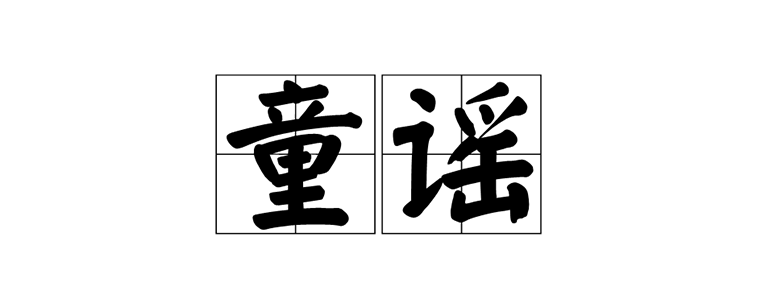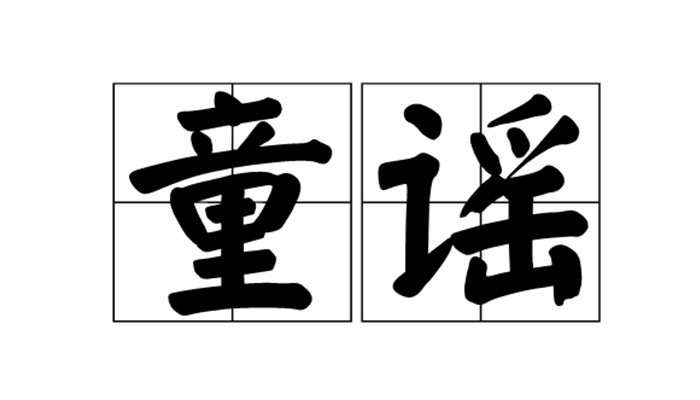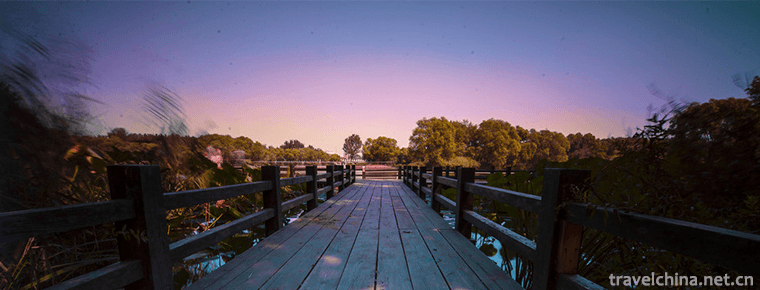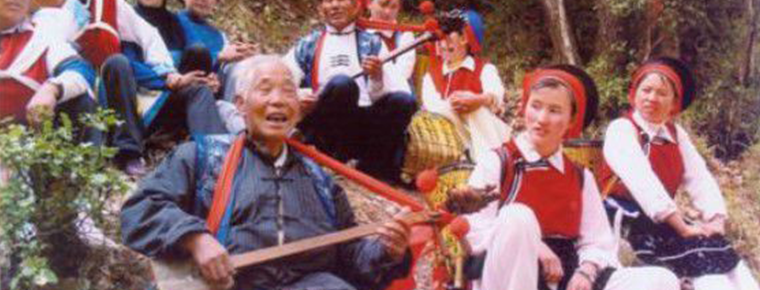2019-01-05

- By ChinaWiki.net
- Chinese Edition
- 2019-06-23
Nursery rhyme
Nursery rhymes are short poems written for children, emphasizing rhythm and rhyme. They are usually spread orally. Many nursery rhymes are processed and spread according to the idioms in ancient rituals, or based on later historical events.
Nursery rhymes are recorded in all nationalities and cultures around the world. For example, China's "Three-character Classic" and Britain's "Twinkle Twinkle Little Star" and so on.
On June 7, 2008, Beijing nursery rhymes were approved by the State Council to be included in the second batch of national intangible cultural heritage lists.
History
Nursery rhymes have a long history. They first began in the Book of Songs when there were peaches in Weifeng Garden - "My heart is sorry, I sing and sing." The Kangqu nursery rhyme recorded in Liezi is said to be the nursery rhyme of the sage Yao in Chinese legend. "Ancient and Modern Things Textual Research" said: "Liezi said:'Yao Naiwei swam in Kangqu, heard children's ballads...' From the beginning of the rumor, Yao Shiran. Some people think that the book Liezi is not necessarily reliable, but only acknowledge that the nursery rhyme recorded in Guoyu Zhengyu is the real earliest nursery rhyme. Even so, nursery rhymes have a history of nearly three thousand years. In the literary history of our country, only some chapters in the Book of Songs can be compared with its old qualifications.
Looking at the history of ancient Chinese nursery rhymes, we can find an obvious dividing line: before the Ming Dynasty, almost all nursery rhymes were political nursery rhymes, which were tools of political struggle to varying degrees, and they had nothing to do with children's lives; from the Ming Dynasty, while continuing to develop political nursery rhymes, a number of nursery rhymes, or rather, those that truly reflected children's lives, came into being. At this time, some people consciously began to create and collect nursery rhymes in the true sense. I think there were probably non-political nursery rhymes before the Ming Dynasty, but they were annihilated because no one had collected and recorded them; even if they had written down a little, they were often attached to politics. The Ming Dynasty was a period when a large number of capitalist factors came into being in China. At that time, a group of people broke through the shackles of Neo-Confucianism in Song and Yuan Dynasties, and their thoughts were relatively liberated. Their horizons have expanded to unprecedented areas, and with the flourishing printing industry at that time, the creation or collection of nursery rhymes has achieved better results. The earliest existing collection of children's songs in China was "Performing Children's Language" compiled by Lu Kun in 1593 in the Ming Dynasty. Since then, there have been more and more collections in this field.
From the existing materials, the ancient nursery rhymes in our country generally present the situation of "more than two, less": more troubled times, less prosperous times; more late dynasties, less early dynasties. Like the Wei, Jin, Southern and Northern Dynasties, Five Dynasties, Ten Kingdoms and Yuan Dynasty, there were many nursery rhymes reflecting the political struggle in this period. In every dynasty, there were more nursery rhymes in the late period than in the early and middle period, such as the late Qin, the late Han, the late Yuan and the late Ming Dynasty. The reason for this is that in troubled times and the end of the world, political struggle is sharp and complex, and all kinds of political forces are trying to express themselves, including nursery rhymes to create public opinion for themselves. Therefore, there is fertile soil for nursery rhymes. On the other hand, at this time, the ruler's restraint was relatively weakened, so that the nursery rhymes produced could not be completely strangled. The new rulers are willing to retain the nursery rhymes which create public opinion for themselves, even those which curse the overthrown rulers, they tend to have a tolerant attitude, and even are willing to record them as proof that they "conform to the heart of heaven and the will of the people". Conversely, in the early and middle stages of each dynasty, the rule of the ruling class was relatively stable. In addition to praising Shengping, it was not easy to create and preserve truly combat nursery rhymes.
educational value
Intellectual Education
Children's knowledge is shallow, life experience is limited, and the content of children's songs is mostly to describe the general life scenes, folk festivals congratulations, or natural scenes such as sun, moon, stars, wind, rain, thunder and lightning, astronomy and meteorology, and even imaginary plots about fish, insects, birds, animals, flowers, plants, trees, color figures, etc., not only vivid. Interest, in line with children's appetite, and the theme is all-inclusive, can better satisfy children's curiosity. Therefore, children can acquire new experience and knowledge from nursery rhymes.
Interest Education
The content of children's songs, with special emphasis on emotion and interest, can cultivate children's temperament, change their temperament, and make them develop a lively, bright, elegant and naive character. Didn't Confucius say, "Poetry can be enjoyed, watched, grouped and resented"?
Literature Education
Children's songs enrich children's vocabulary and enhance children's expressive ability. The words and sentences in children's songs are usually plain and concise. Because of its simplicity, children can easily understand its meaning, appreciate its interest, appreciate the artistic conception in the period, and quickly learn new vocabulary; because of its simplicity, children can easily learn vivid and beautiful sentences, which virtually enhances children's language expressive ability. To further say, children's language ability is from simplicity. The vocabulary gradually accumulated and developed. They not only expanded the field of knowledge from the various vocabularies they absorbed, but also enhanced the ability of association and narration from the use of these vocabularies.
Moral Education
Some children's songs also contain the educational content of ethics or exhortation and irony to teach loyalty and filial piety, so that children can get the benefits of pottery casting character and beautifying the soul. Therefore, if we apply nursery rhymes to the teaching activities of music, dance, drama, entertainment and other disciplines, we can achieve a more lively teaching effect. In the teaching activities of semi-recreational and semi-learning, children will have a deeper understanding of the emotion and artistic conception in poetry, thus being deeply and concretely edified. In this way, it can not only adapt to the physical and mental development and needs of children, enrich their self-cultivation, and educate children's morality, but also receives a subtle effect.
educational value
The Educational Value of Nursery Rhymes to the Development of Children Aged 3-6
Famous pediatrician and Professor Jinbo of Capital Normal University believes that good nursery rhymes are soul chicken soup, which can nourish children's soul and help them grow up healthily. Children can easily master this literary form of nursery rhymes. By singing nursery rhymes, they can not only get happiness, but also learn knowledge, which is very helpful to children. Form a good aesthetic ability. And it plays a subtle and irreplaceable role in shaping children's happy and optimistic personality, forming ideological and moral character, cultivating good feelings, cultivating behavior habits, and even nurturing the aesthetic feeling of Chinese language. We hope that through the teaching of nursery rhymes in our garden, nursery rhymes can enter our hearts, inherit the virtues of the Chinese nation, and learn to appreciate, feel and express beauty. I spent a wise and happy childhood here.
Spring Festival Tales and Nursery Rhymes
In old Beijing, New Year's Day is the happiest thing for children. A series of nursery rhymes accompanied by children's tender children's voices, crisply into thousands of families, in deep alleys, in the ancient courtyard for a long time.
As soon as December comes, there will be a new year's flavor. Children are looking forward to the Spring Festival, especially those with poor families. They can't wear new clothes or eat any good things at ordinary times. But when the New Year comes, their parents will be tired and hard again. They will also prepare some food and drink for their children and make new clothes.
At that time, as long as one drinks Laba porridge, the year is not far away. So the children sang nursery rhymes:
Children and children, please don't be grumpy, after Laba is the year;
Laba porridge, drink for a few days, mile Lala 23;
Twenty-three, sugar melon sticky; twenty-four, house sweeping;
Twenty-five, frozen tofu; twenty-six, to buy meat;
Twenty-seven, slaughter the cock; twenty-eight, put the face on;
Twenty-nine steamed steamed buns; 30 nights boil a night;
The first and second day of junior high school are full of streets.
Because people from every household in the first and second year of the New Year are going out to pay New Year's greetings, people come and go all over the street at this time. This nursery rhyme vividly summarizes the whole custom of busy New Year's celebration, which has been widely circulated in Beijing for many years. Funny... Funny... Begging, begging and begging; New Year's Cake dipped in sugar, dates, chestnuts, big crabapples.
To celebrate the Spring Festival, adults will go to the streets to buy New Year's Goods, while children will follow adults and ask for all kinds of delicious and interesting things. At that time, there were many kinds of snacks and fruits on the street. The sellers spread the New Year's Cake on the case, bought how much, cut it with a knife, then put a spoonful of sugar on it, and the children dipped it in sugar. When the twentieth day of the twentieth lunar month marks the beginning of the new year, the children say again:
Sugar melon sacrificial kitchen, New Year's arrival;
Girls want flowers, boys want cannons;
The old man needs a new felt hat.
The old lady needs a new cotton jacket.
The sacrificial kitchen is an old custom in the Spring Festival. Once the kitchen is sacrificed, it is closer to the New Year. At this time, children can not only eat Guandong sugar, but also go to the streets to buy a variety of firecrackers. Thirty nights, put on your new clothes, light the lanterns, and enjoy yourself. After setting off firecrackers, after eating dumplings in the middle of the night, we have to kowtow to our elders to celebrate the New Year. The nursery rhyme says:
Samsung in the south, home New Year's greetings;
The kowtow of the younger generation, the money of the older generation.
If you don't want money, turn your face and leave.
At this time, the children became very good, kowtowing to the old people one by one. The old people looked at their grandchildren and granddaughters with a big smile. Each of them had to send a small red envelope for children's safety and good luck. The red envelope contained lucky money.
In the past, when children said nursery rhymes, they often added words improvisely. Maybe some of them read the nursery rhymes out of tune, and some of them were for the sake of speaking up. So sometimes there are several versions of a nursery rhyme. Generations of children say and sing like this, grow up, walk out of the courtyard, out of the alley. However, the old Beijing style remains unchanged, well preserved in one nursery rhyme after another.

Ask a Question
Your email address will not be published.



0 Questions